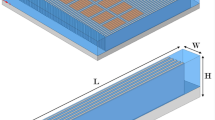Abstract
Metal cellular material is a new material attractive for its light weight and potential multifunctionality. In the present paper, we study cylindrical structures made of linear metal cellular material. The outer surface of the cylindrical structure is subjected to thermal boundary condition, and cooling fluid is forced through the cylinder to remove heat through the inner cell walls. Optimum design aims at maximization of heat dissipation efficiency under prescribed flow pressure. Two classes of design variables, relative density, and local aperture distribution of cellular material are to be determined by optimization under given total material volume constraints. Although similar to the structural topology optimization concept of material distribution, our formulation results in a structure with realistic cellular material of finite-sized aperture. Numerical results for different cross-sectional shapes and thermal boundary conditions are presented. Interestingly, our present formulation leads to optimum designs for cellular structures that mimic natural biomaterials. We discuss in general the guideline for cellular structure design to maximize heat dissipation efficiency based on insights from these optimization results.
Similar content being viewed by others
References
AsakoY, Nakamura H, Faghri M (1988) Developing laminar flow and heat transfer in the entrance region of regular polygonal ducts. Int J Heat Mass Transfer 31:2590–2593
Banhart J (2001) Manufacture, characterisation and application of cellular metals and metal foams. Prog Mater Sci 46:559–632
Bendsøe MP (1989) Optimal shape design as a material distribution problem. Struct Optim 1:193–202
Bendsøe MP, Kikuchi N (1988) Generating optimal topologies in structural design using homogenization method. Comp Meth Appl Mech Eng 71:197–224
Chellappa S, Diaz AR, Bendsøe MP (2004) Layout optimization of structures with finite-sized features using multiresolution analysis. Struct Multidiscipl Optim 26:77–91
Eschenauer HA, Olhoff N (2001) Topology optimization of continuum structures. Appl Mech Rev 54:331–390
Evans AG (2001) Lightweight materials and structures. MRS Bull:790–797
Evans AG, Hutchinson JW, Ashby MF (1999) Multifunctionality of cellular metal systems. Prog Mater Sci 43:171–221
Gibson LJ, Ashby MF (1997) Cellular solids: structure and properties, 2nd edn. Cambridge University Press, Cambridge
Gu S, Lu TJ, Evans AG (2001) On the design of two-dimensional cellular metals for combined heat dissipation and structural load capacity. Int J Heat Mass Transfer 44:2163–2175
Hayes AM, Wang A, Dempsey BM, McDowell DL (2004) Mechanics of linear cellular alloys. Mech Mater 36:691–713
Lu TJ (1999) Heat transfer efficiency of metal honeycombs. Int J Heat Mass Transfer 42:2031–2040
Lu TJ, Chen C (1999) Thermal transport and fire retardance properties of cellular aluminium alloys. Acta Mater 47:1469–1485
Lu TJ, Stone HA, Ashby MF (1998) Heat transfer in open-cell metal foams. Acta Mater 46:3619–3635
National Physical Laboratory (2000) Review of industrial survey on metallic foams. http://www.npl.co.uk/npl/cmmt/metal_foams/survey_results.html
Olhoff N (1996) On optimum design of structure and materials. Meccanica 31:143–161
Rodrigues H, Guedes JM, Bendsøe MP (2002) Hierarchical optimization of material and structure. Struct Multidiscipl Optim 24:1–10
Sigmund O (1995) Design of material structures using topology optimization. In: Olhoff N, Rozvany GIN (eds) WCSMO-1: First world congress of structure and multidisciplinary optimization. Pergamon, Oxford, UK
Sigmund O, Torquato S (1997) Design of materials with extreme thermal expansion using a three-phase topology optimization method. J Mech Phys Solids 45:1037–1067
Author information
Authors and Affiliations
Corresponding author
Rights and permissions
About this article
Cite this article
Wang, B., Cheng, G. Design of cellular structures for optimum efficiency of heat dissipation. Struct Multidisc Optim 30, 447–458 (2005). https://doi.org/10.1007/s00158-005-0542-0
Received:
Revised:
Published:
Issue Date:
DOI: https://doi.org/10.1007/s00158-005-0542-0




